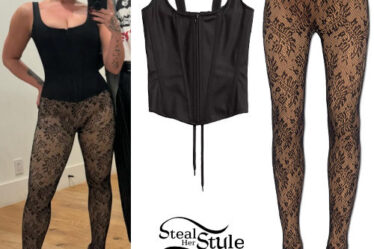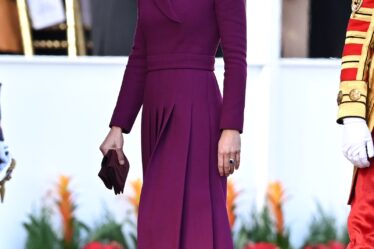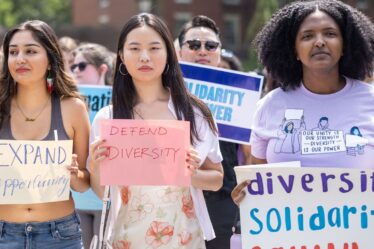PARIS — Chanel has enlisted Hollywood A-listers Brad Pitt and Penelope Cruz as it tries to take back the narrative surrounding its iconic quilted handbags as rising prices and reports of declining quality tarnish the brand online.
In a handbag campaign first teased at Chanel’s March runway show, Pitt and Cruz re-enact scenes from Claude Lelouch’s 1966 film “A Man and a Woman,” including an iconic sequence where the film’s lovers dine with a Chanel bag sitting between them.
The multimillion-dollar campaign — the French giant’s first major accessories push in two years — has since been rolled out worldwide, and is complete with eye-catching affirmations of the brand’s most iconic codes: quilted handbags, double-C motifs, a black-and-white colour palette, Frenchness, cinema and enduring style.
For Chanel, the campaign couldn’t have come soon enough.
In recent months, the house’s handbags have come under scrutiny on social media amid reports of diminished quality and a series of aggressive price hikes, the latest of which pushed the cost of a medium Classic Flap bag from Chanel above €10,000 ($10,820) for the first time, higher than the price of many sought-after Mini Kelly or Birkin styles from rival Hermès.
Brands across the luxury space have refocused their attention on top-end clients as demand from middle-class shoppers waned amid slowing economic growth and the return of spending on travel and experiences during the past year. The shift has been a boon to blue-chip luxury names like Chanel as well as Hermès, Loro Piana and Brunello Cucinelli, which also got a boost from the “quiet luxury” trend.
Still, it’s unclear how far even the wealthier Chanel customers will stretch their fashion budgets after years of price hikes intermittently explained by currency shifts, inflation or investments in supply chain and sustainability.
“We felt we needed to reaffirm this bag, which is often criticised for its price, for its positioning, but is still the bag that embodies our brand most completely,” Chanel’s president of fashion Bruno Pavlovsky said. “It’s a couturier’s bag made using couture techniques… This bag is positioned as one of the most expensive on the market. It’s a choice the brand has made; and it’s also a reality due to its fabrication. After that, there’s a whole range of smaller bags and other items which remain perfectly accessible.”
The latest rounds of price increases at Chanel have been particularly poorly received amid regular reports of declining quality at the brand, which tend to resonate on social networks like TikTok. In recent months, Chanel-obsessed content creators have complained of everything from crooked stitches to torn calfskin straps to loose or rapidly tarnishing hardware, leading some shoppers to question if one of the world’s most expensive brands is still worth it.
A $17 Billion Brand
Clearly plenty of consumers still think so. Chanel’s business has been on a tear: the privately-held fashion and beauty giant’s sales rose 17 percent in 2022 to $17 billion. While numbers for 2023 aren’t expected before May, Pavlovsky said financial performance in the fashion division has been “absolutely exceptional.”
In France, Chanel bags continued to account for three of the top 5 models in a February ranking of the most recognisable, exclusive and desirable luxury handbags, according to an analysis by Bernstein and Promise Consulting.
But Pavlovsky acknowledged the quality concerns. “We speak about creativity, about ultimate luxury. But quality is always at the heart of our preoccupations,” he said. “We’re not perfect, that’s clear. But we’re really working on all of these subjects, which are truly fundamental… We’re aware that our positioning obligates us to always do better, and we’re always trying.”
To help boost production in response to growing demand while trying to maintain standards, the brand has, in recent years, acquired a number of strategic suppliers, including five tanneries in order to help it secure the best leathers for its bags. “Between what we were making 10 years ago and today there’s a very large evolution. We’ve had to train, invest in, and engage with a great deal of people to get to where we are today,” Pavlovsky said.
Still, Pavlovsky was took aim at critical videos making apples-to-oranges comparisons, such as clips showing the lustrous yellow of gold-plated archival bags shown next to more recent models whose hardware has been galvanised using far more durable (if less golden) finishes. Other items appearing in such videos could even be fakes, he suggested. “There’s 20 or 30 million bags out there in the wild; I can’t sign for all of them.”

‘Absolute Luxury’
Chanel has long promoted its brand by mixing its ultra-classic codes with fashion fabulousness on epic proportions: shows under late creative director Karl Lagerfeld included Chanel-branded rocket ships boosting off in Paris’ Grand Palais or models wearing Daft Punk-inspired helmets and tweed suits reworked to look like computer chips.
In recent years, his successor Virginie Viard has brought the brand closer to earth, ushering in a more relatable, wearable chapter for Chanel. While the brand’s double-C clad collections hardly constitute “quiet” luxury, a reinforced focus on timeless codes — as well as reinforced prices — suggest a desire to compete with Hermès, better known for purveying a 360-degree luxury lifestyle than driving the fashion agenda.
“We are positioning ourselves as a house of absolute luxury,” Pavlovsky said. “We’ve always valued creativity, but it’s not creativity for its own sake. It’s creativity as a way of looking at luxury, and always with a high attention to quality.”
Still, justifying an “absolute luxury” positioning may require more than a star-studded campaign and the supply chain upgrades the company has made thus far.
Last week, the fashion conversation on social media was focused less on Chanel’s Pitt and Cruz ads than on the eye-popping price tags on this season’s merch: could a $975 pair of Chanel logo-ed flip-flops possibly be worth it?



